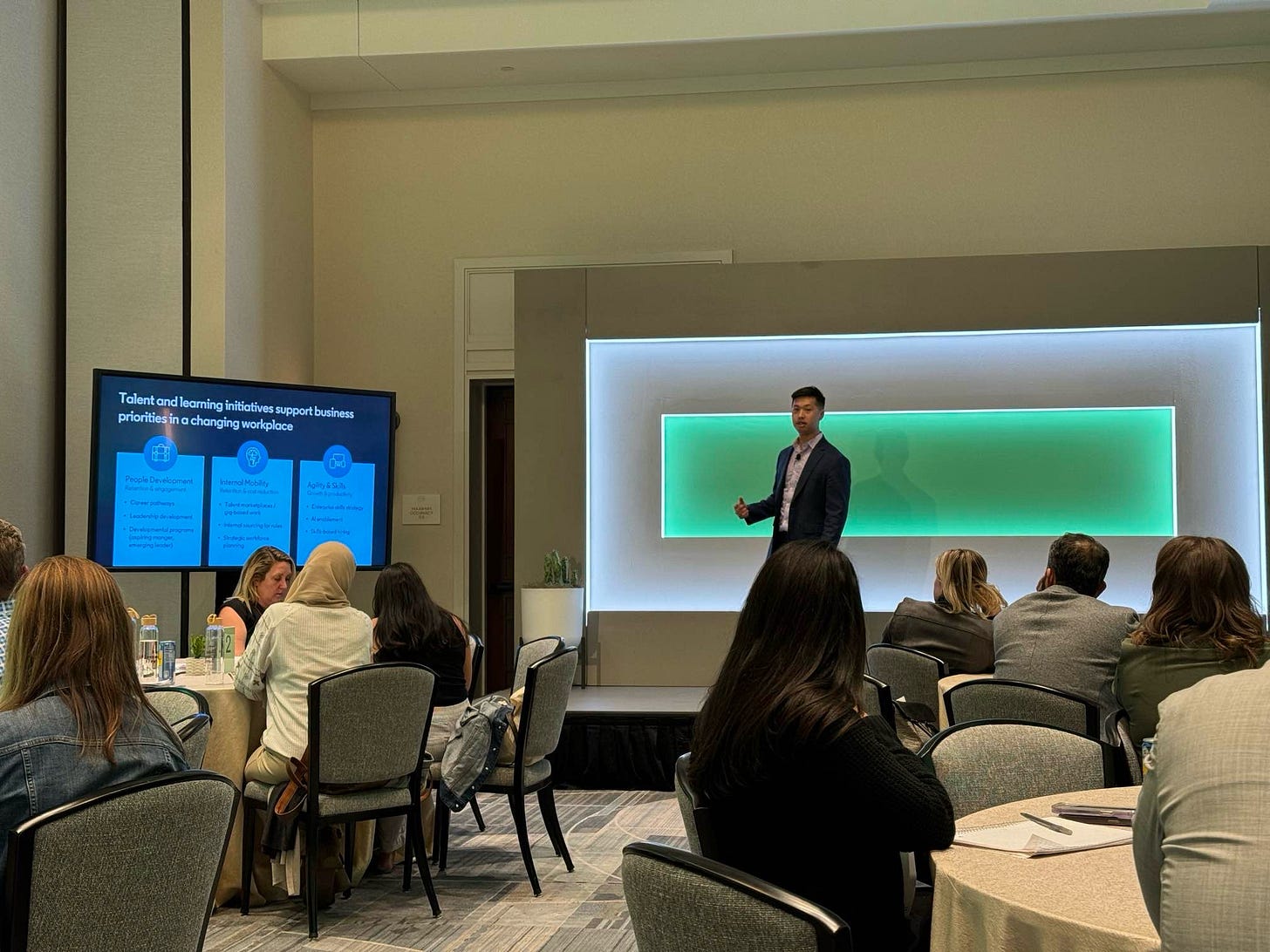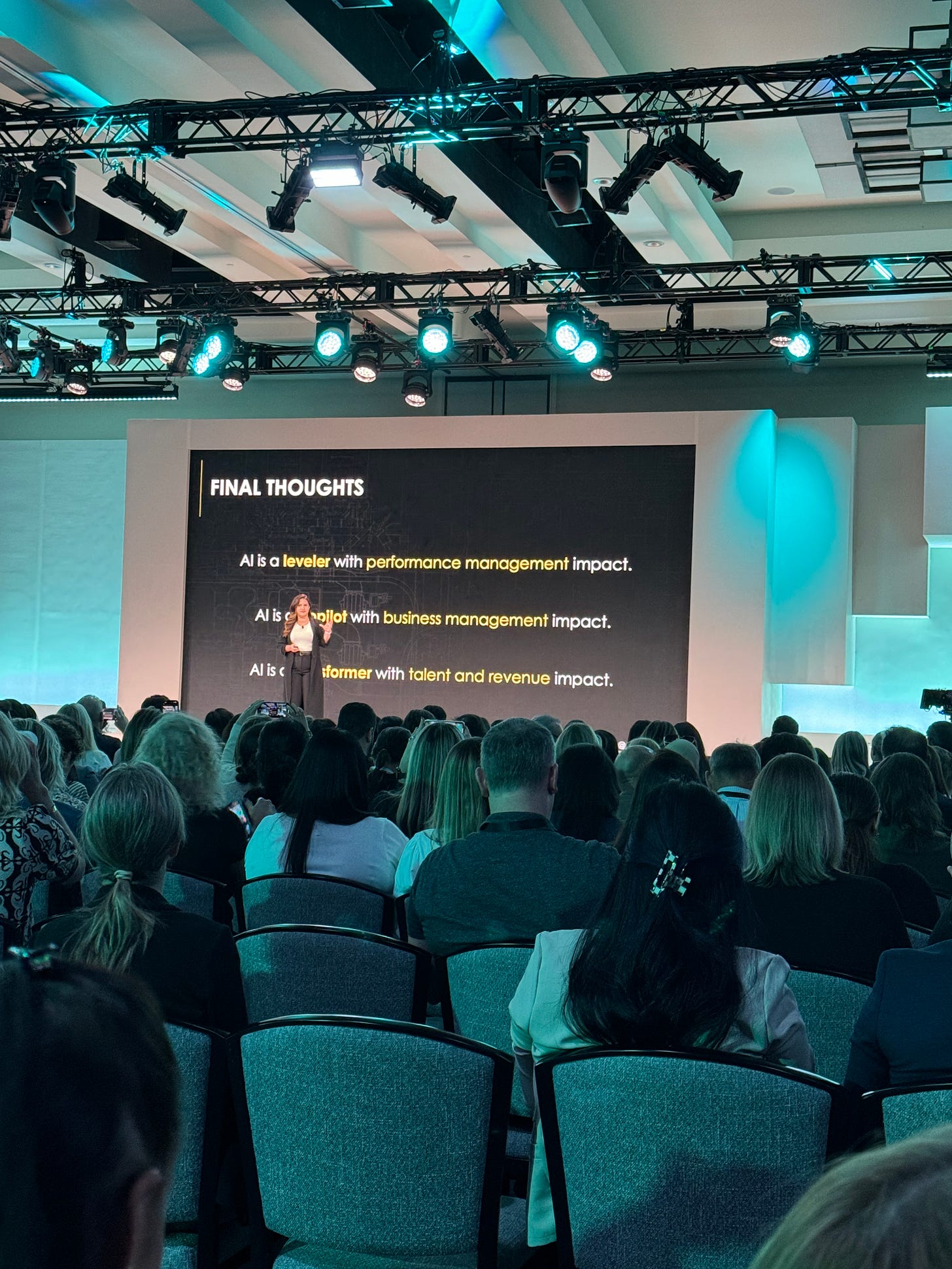To Unlock The Potential of AI, Think Differently About Work
3 Frameworks to Unlock Possibilities with Work and AI
For the past eight weeks, I’ve been on the road, attending conferences, delivering leadership training, and speaking and coaching talent and learning leaders. One recurring topic has stood out: AI.
Given the rapid use/deployment of AI through platforms like Perplexity, Gemini, and OpenAI, along with the steady stream of innovation from these companies, it’s no surprise that AI is central to so many discussions. And since it’s already made its way to both work and personal parts of our lives, it’s hard to ignore its potential impact.
During this time, I’ve reflected on how AI will impact the work we do, the ways we’ll develop and retain employees, and the evolving role and skills needed for leadership in this new world of work. While the technology itself is fascinating, what interests me most is the opportunity AI offers us to think more expansively about work itself.
Here’s a thought experiment: Is your current work setup truly optimal? Are you doing the tasks you find most valuable? Is your approach the most effective and fulfilling it could be? Likely, there are aspects of your daily work that feel imperfect or inefficient.
Although it’s unrealistic to expect AI to solve everything, the current moment encourages us to rethink and potentially reshape our work to make it better, sometimes with AI as an enabler.
AI isn’t a fix-all, and it won’t be applied to every aspect of work. However, this period gives us a chance to reset, to truly rethink how we want to work. More than simply understanding technology, we need to reimagine our approach to work itself.
As Albert Einstein once said, “You cannot use an old map to explore a new world.” We now have a unique opportunity to explore new ways of thinking about work—yet, relying on old frameworks won’t carry us far into the future.
While individual experimentation is valuable, there’s also an opportunity for all of us to envision how AI and other technologies can contribute to creating a better work experience.
But to make meaningful changes, we can’t lean on the same frameworks that brought us here.
Achieving different results requires a new way of thinking about our work, with technology integrated as a supporting factor.
Over the past few weeks, I’ve spoken with hundreds of professionals across various functions and industries. Their perspectives on AI range from excitement to caution, and everything in between. Putting technology aside for a moment, I’d like to share three frameworks—tools for thinking about work differently.
These frameworks can help us, regardless of industry or role, create a work environment that truly works for us, aided by the potential of AI.
The three frameworks are:
Looking Future Back Versus Present Forward
Identifying the Categories of Our Work
What Could You Be Doing
1.Looking “Future Back” Versus “Present Forward”
When we aim to make improvements—whether to a process, task, or project—we often start by fixing what's already there. Many current AI tools operate this way, using technology to make incremental enhancements to existing functions. While valuable, this approach limits our capacity for true innovation because it begins with what already exists.
A better and more transformative way to think about this is to think about where we’d like to be in the future, think about where we are today, and ask ourselves, “how do we bridge that gap?”
We are seeing this now with many of the early examples of AI tools and technologies that take what we are doing today, and make it better, faster, or cheaper. To be sure, there is business value in doing this, but to get to the potential transformative aspects of AI and technology, we have to think differently from how we operate today.
Bridging that gap requires us to think differently about what’s possible. This approach might feel awkward or even silly at first, and that’s okay—the goal is to expand beyond today’s limits and explore what could be.
How to use this Framework:
Ask yourself the following questions:
Imagine yourself in your current role but 5-10 years into the future. What would an ideal state of this role be like? What would you be doing, how would you be operating without constraint?
Where are we today?
What would it take to bridge that gap?
2. Identifying and Prioritizing Categories of Work
If we break down the work we do each day to the essence of it, we usually come into categories of things like the following:
Meeting and Collaborating
Thinking and Reflection
Analyzing Information
Communicating
Creating
Searching
In order for us to be productive and successful in our work, we probably need to do some of all of these things. But not all of us love to do all of these things all of the time. For many of us, some of these categories of tasks and projects are things that drain us, and in some cases, are not really that helpful. And even when we want to get to do the things we want to do, inevitably, we get interrupted, or because of the nature of work, have to drift back into another category. Taking time for creating as an example. Maybe you have to create a presentation, but because all of the data you need lives in 10 different emails, you actually spend most of your time searching.
This framework involves taking the work that you do (tasks, projects, deliverables) and then categorizing them at the most granular level possible to see how much time you spend in each of these categories. This is a helpful exercise to see how you are spending your time, and what you are doing.
From there, you can start to think about questions like, is this the most optimal use of my time? If not, what is? If I were to free up time (ex: b/c of technology or AI) where could I shift my time towards?
How To Use This Framework
Use the six categories of work as a frame, and identify based on the work you do, how much of your time for your tasks and projects is spent in each six of those categories
Then, identify an ideal mix/breakdown (percentage or time is good) of what you’d like tha to be
Ask yourself the following questions:
What would have to be true for me to achieve this ideal state?
What would go away? What would i take on?
What kind of resources would I need to achieve this ideal state?
3.What Could You Be Doing?
For many of us, there are not enough hours in a week or in a day to do all the things we want to do. Not to mention, most of us work in organizations that don’t have an infinite amount of budget, resources or headcount.
But what if this weren’t the case? What if we could find more resources, slack, or hands to help us get that work done? How would that change our ability to do more work?
AI won’t be able to do everything you want it to do, but even in the early AI tools that we have for our work today, you can see how it could potentially unlock time and resource constraints that would enable you to get to that project that you never hard time for.
At a minimum, it is a very good thought starter to get you thinking about what you might be able to do if you had more time or resources that would allow you to make a greater impact. In the future, some of these things could be A) done by you because you give other things to machines B) done by you and a machine collaboratively or C) done by a machine.
Go look at the last quarter or half year, and identify the projects, priorities, or responsibilities that you wanted to do but couldn’t do.
How To Use This Framework
Go look at the last year of work, and identify the key projects you worked on
Then, identify the things you either A) wanted to do but didn’t have time or B) stopped doing because you had too many priorities
Then, ask yourself the following questions:
What else could I do if I had more time?
What kind of impact would I have made if I could have taken on these projects with the help of AI?
How would this change my role or the impact of my work?
Thinking Differently About Work
These are still a work in progress, so I would love to hear your thoughts and what you think. One more Einstein quote for you to close out which is this: “We cannot solve the problems of today with the same thinking that created them”
If we want to explore what’s possible with AI and truly reshape how we work, we have got to start by thinking and working differently about it. I hope these three frameworks are a way forward to get us started.
If you’re looking for some help for your learning and development, leadership development, I’d love to work with you: Here is how I might be able to assist:
Leadership & Learning Programs: Formal training and leadership development in your company, such as new manager or new leader training, or skill-based programs.
Consulting & Advisory Services - Do you have a leadership development or onboarding program that needs a refresh or audit? Let’s chat about how we can improve your program.
1:1 Executive Coaching - Are you looking for an executive coach for 1:1 leadership support? Let’s chat about how we can work together
Feel free to contact me directly for more details!
Have a great week!
Al




